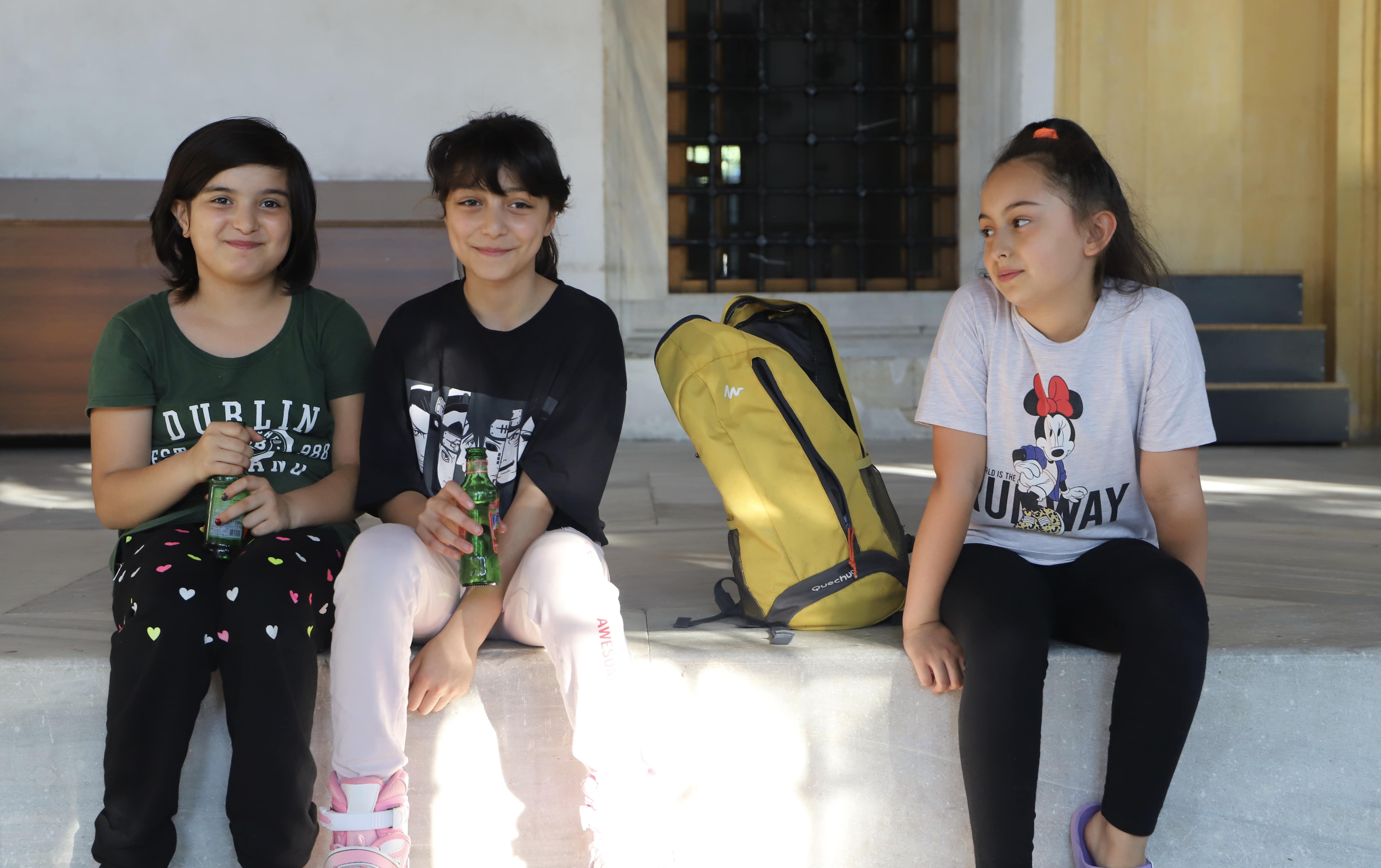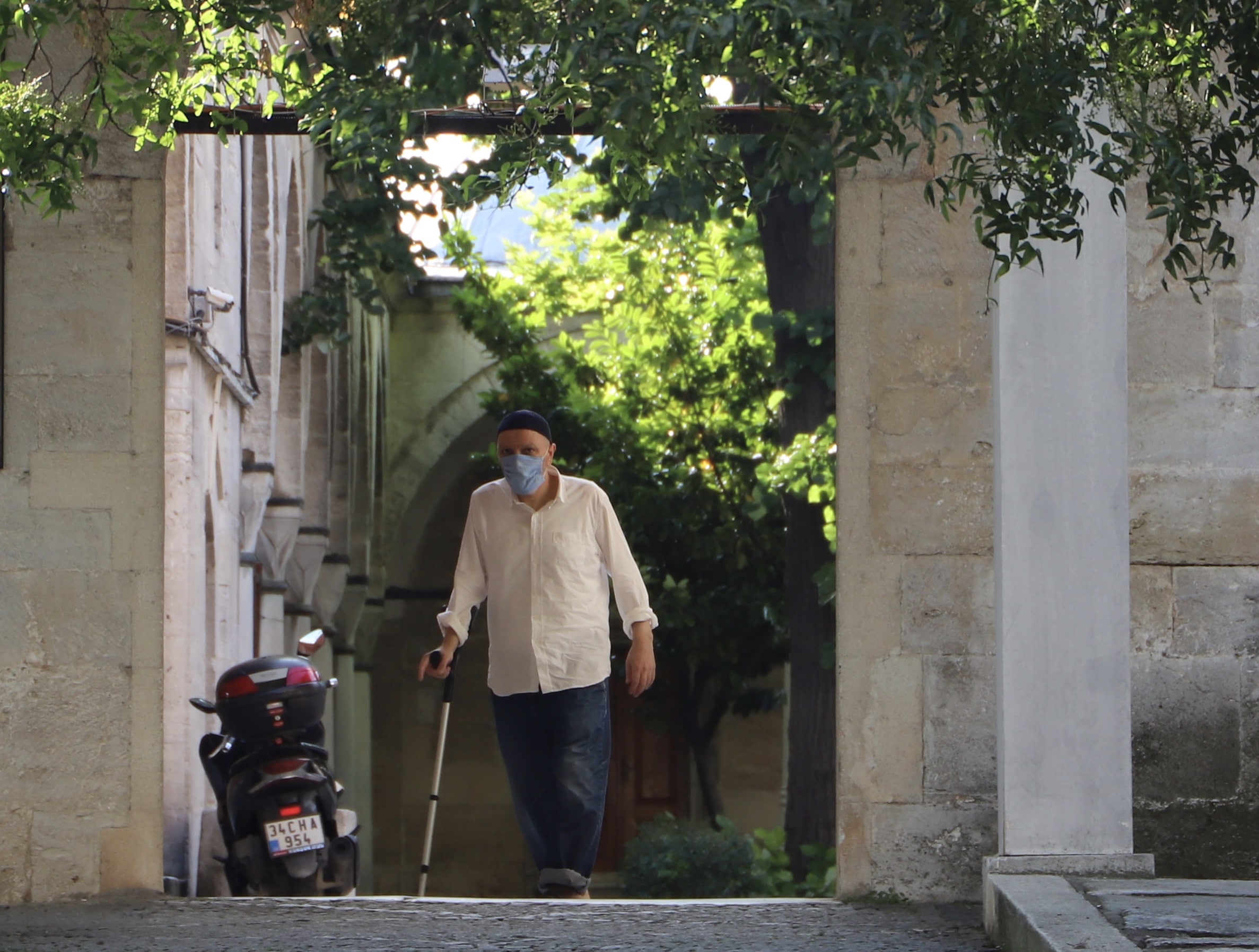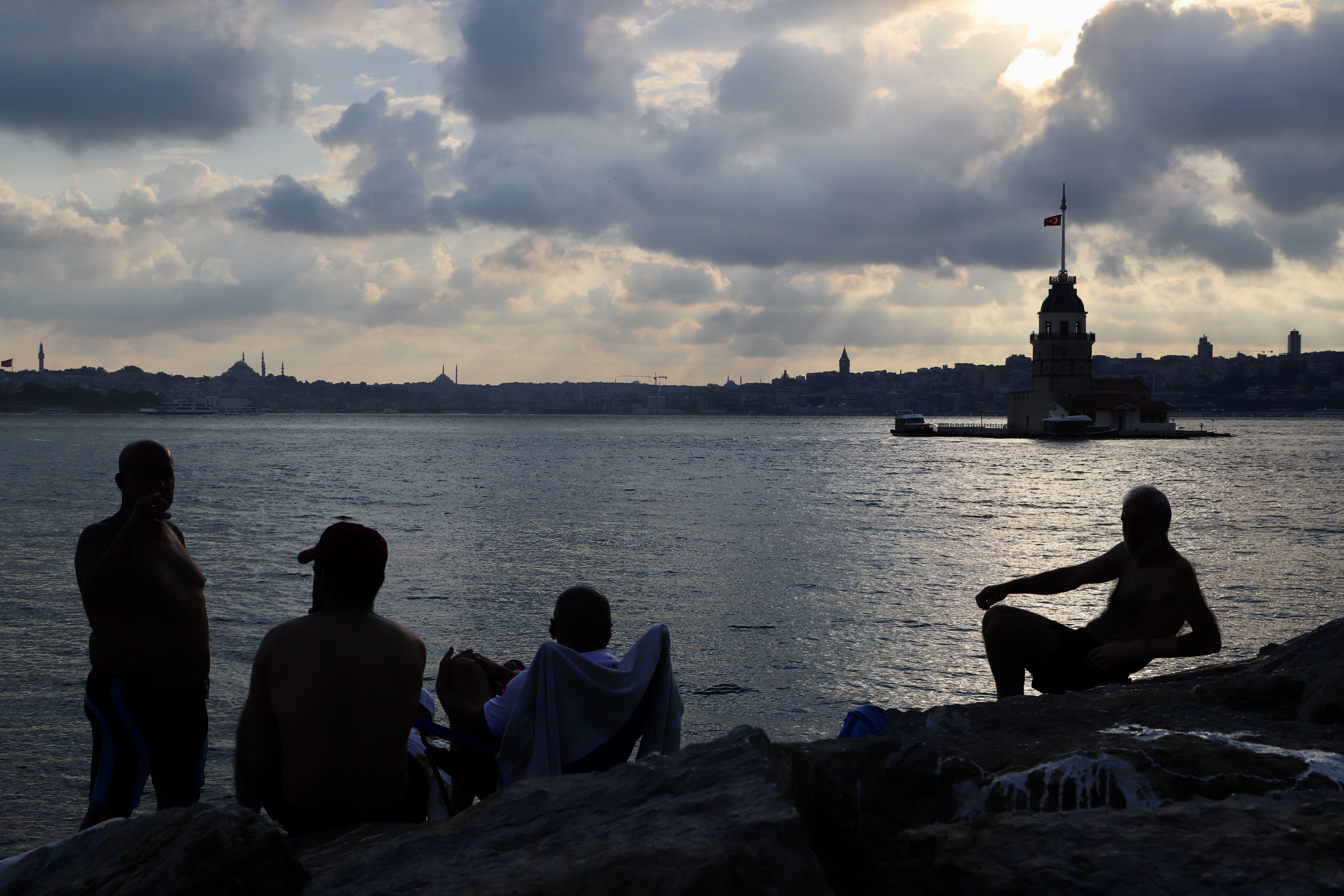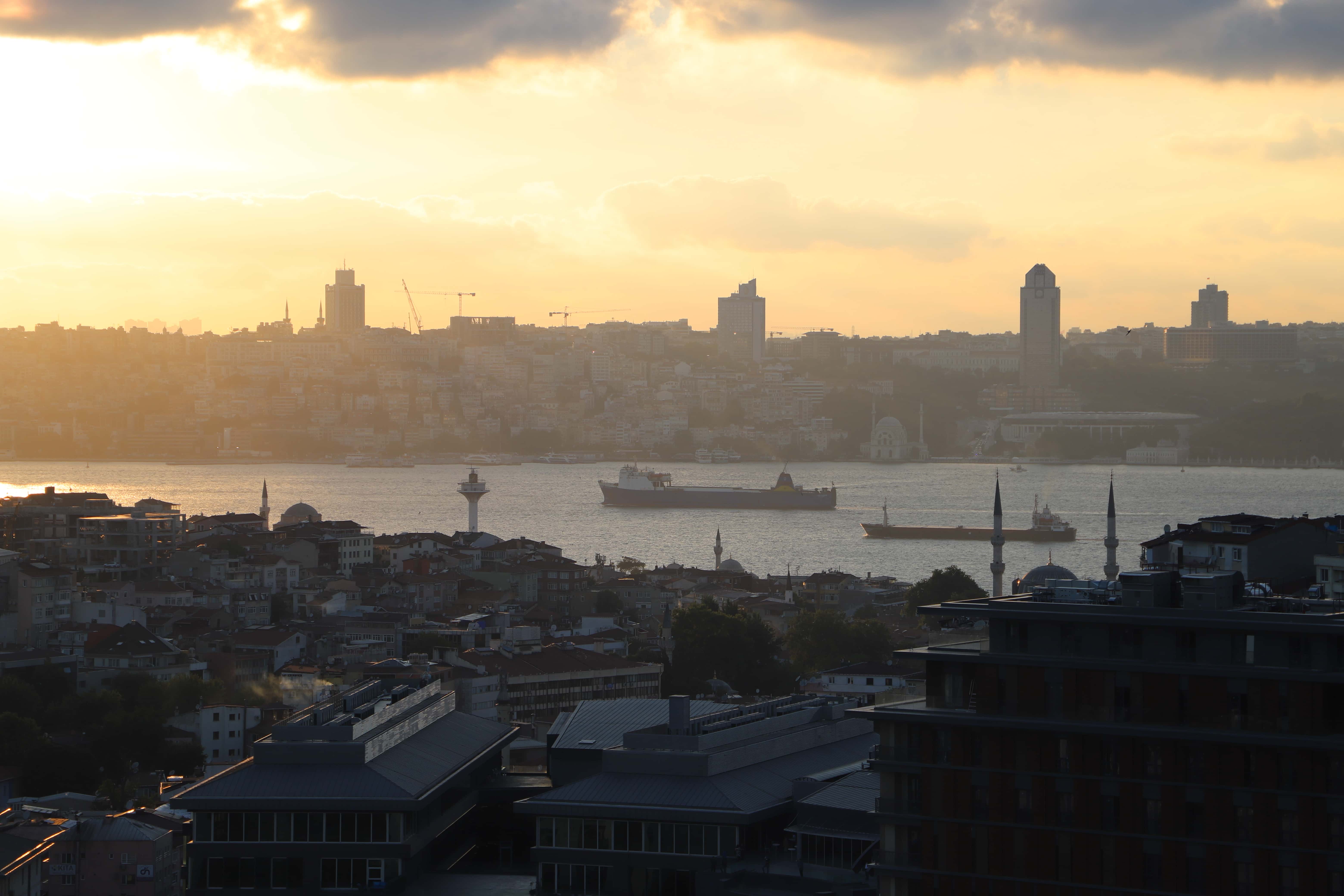Though beloved by Sufis and sultans, Üsküdar was not spared the ground-shaking reforms of the 19th and 20th centuries. In the second half of our story, we look at how Istanbul’s ‘holy land’ has fared in its two-century tryst with modernity.
As the intersection of Istanbul’s military and commercial activities with Persia, Armenia, and Central Asia, Üsküdar was always oriented to the East. Unlike European Istanbul, where Greeks and Jews often dominated trade with Europe, Üsküdar’s leading merchants were Armenians, Arabs, and Iranians of Turkish-Azeri origin. As the poet Ömer Erdem grandly put it: “Üsküdar is Asia, from here to China.”[1]
By the time Evliya Çelebi got to writing his majestic mid-17th century Seyâhatnâme, the defining travelogue of the early modern period, Üsküdar had 11 caravansarays, a 2,600-shop indoor market, and dozens of yalı, or wooden mansions, along its southern coast.
Just as it had with Byzantine emperors, leading Ottoman statesmen and wealthy Muslims often had their summer residence in Üsküdar—a trend made yearlong when a 32-year old employee of the Istanbul Tunnel and Tramway Authority (and future Istanbul mayor and Turkish president) called Recep Tayyip moved there in 1986 from the working-class quarter of Kasımpaşa, itself but a stone’s throw from the bright lights and bustle of godless Beyoğlu.
Tellingly, however, even Üsküdar’s cosmopolitanism only came in several flavors. Unlike so much of Istanbul, which was 56% non-Muslim by 1900, Üsküdar’s inhabitants remained overwhelmingly in the Dar al-Islam. As Evliya Çelebi, himself a longtime resident, noted with satisfaction, the Üsküdar of his day boasted 70 Muslim quarters (mahalle), 11 Greek and Armenian ones, and one Jewish mahalle, but “not a single Frankish one.”[2]
That does not mean non-Muslims did not play an important role. Not only was the central market full of Armenian, Kurdish, Albanian, Greek, Jewish and Bulgarian merchants. Like in so much of Turkey prior to WWI, relations were especially warm with the Armenians, who until the 19th century were uniformly referred to as the empire’s ‘Loyal Nation’ (Millet-i Sadıka).
The loyal nation within
Though faded, Üsküdar’s centuries-old Armenian community has long been one of the most important in Istanbul. Centered around the neighborhoods of Bağlarbaşı and Kuzguncuk,[3] many of the community’s most renowned landmarks are here.
Among these are the Özel Surp Haç Tıbrevank High School, which since 1706 has produced many of Turkey’s leading Armenian intellectuals. These include the late Hrant Dink, the journalist and founder of Agos newspaper, and Yetvart Tomasyan, the founder of Aras, the republic’s flagship Turkish-Armenian publishing house.
Up the hill is the Surp Haç Cemetery. Founded in 1555, the oldest Armenian graveyard in Istanbul hosts many of the former imperial capital’s most notable Armenians. Chief among these is the remarkable Balyan family, who for five generations were the Ottomans’ leading palace architects. Authors of half the mosques, palaces, and administrative buildings that dot the Bosporus to this day, no less than eight Balyans attained the status of ‘royal architect’.[4]
Üsküdar also gave birth to Zabel Yesayan, one of the most prolific Armenian writers of the 20th century. One of the empire’s most celebrated female writers, her life was as colorful as it was tragic. Not only did her 1911 masterpiece, Among the Ruins, an account of the 1909 Adana massacres, make her the only woman on the list of Armenians drawn up for arrest and deportation on April 24, 1915, the ‘official start’ of the genocide. Though she managed to escape to Soviet Armenia, she was later accused of ‘nationalism’ and perished in Stalin’s purges.
Though Üsküdar today has but a fraction of its Armenian community, their legacy survives in untold ways. Not only does every local chronicler bemoan the ‘departure’ of their Armenian ahbaplar (buddies). In quarters such as Selamsız, now Üsküdar’s most notorious, locals rue the ‘loyal nation’s’ replacement by Roma. Like empty seats on the ferry, even their absence has a voice of its own.

Our kind of Muslims
“Üsküdar has always been inhabited by urban(e) Muslims,” says resident and Boğaziçi University professor Sevengül Sönmez. “The kind who don’t bother about how you dress or what you do with your free time. No one bats an eye when I wear a skirt or a low-cut top,” she jokes. There are no-no’s, to be sure—chiefly public drinking or public displays of affection—but few taboos beyond what’s kosher at any international airport.
Though one of Üsküdar’s mottos has always been “delisi de velisi de bol” (“full of saints and screwballs”), the largest source of employment for the past 200 years has been the famous Selimiye Barracks.
Built at the turn of the 19th century in the hopes of bringing much-needed reforms to the Ottoman military, the barracks’ first iteration was burnt to the ground by Janissaries who opposed the reforms embodied in their very construction: to house a new Anatolian-raised, European-trained military force, the Nızam-ı Cedit. Rebuilt in 1826, the Selimiye opened just in time for the ‘Auspicious Incident,’ during which 4,000 Janissaries were burnt alive in one final push to abolish the corps.
Tellingly, the barracks’ influence has often been as liberal as it has conservative. Ferhat, a leftist writer, recounts how his father, a senior officer, procured a liquor license for the diner across the street from the barracks after tiring of walking five blocks for his afternoon rakı. There were bigger changes, too. When political violence in the 1970s split the country’s youth between nationalists and revolutionaries, the more prosperous neighborhoods around Selimiye all went communist.
Awkwardly supporting Hegel’s claim that ‘war is progress,’ the barracks also gave birth to modern nursing. Repurposed as a military hospital during the Crimean War (1853-56), it was at Selimiye that Florence Nightingale spent two years treating thousands of sick and wounded Ottoman, French, and British troops. Overwhelmed by their crushing fatality rates, she implemented a number of aggressive hygienic measures that soon proved successful and were thenceforth implemented in hospitals around the world.
The vahdet of Atik Valide
Though officers and grocers no longer bathe at the same hamam or take their families to picnic at the same parks, one writer laments, Üsküdar still has a remarkable vahdet, or oneness.
No neighborhood represents this spirit better than Atik Valide.
A fifteen-minute walk up the hill from the harbor, Atik Valide is the crown in the trifecta of Üsküdar’s three matriarchal mosques. Offering much needed respite from a hot summer’s day in this city of 16 million, its large but intimate courtyard of ancient cypresses and plane trees is crowned with a charming şadırvan[5], around which local children bike or roller skate.
After prayers, half the congregants stick around to sip tea, smoke, and chat in the courtyard. Though the chief imam thoroughly disapproves of tobacco, that doesn’t stop half his congregants from puffing the afternoon away.
Moreover, if Friday has been a workday in Turkey since 1935, you wouldn’t know it. Though some congregants are retired and others unemployed, you get the sneaking suspicion that even praying men have long cut back to a 4-day workweek. Whatever one’s motives at Atik Valide, profit is not one of them.
A mosque is not a mosque
With social distancing still in place, half the congregants pray from the courtyard. One such worshipper is Ahmet. Sitting cross-legged in the grass, he’s decked out in a long beige vest and little green prayer cap, an arrangement made all the more intriguing when we see him lighting up a cigarette in jeans and a short-sleeve button-down barely 20 minutes later.

Though a devout man, Ahmet doesn’t expect everyone to be. “Everyone knows the Asian side of Istanbul is more conservative,” he says. “But no one’s forced to go to mosque or pray. Even Üsküdar’s grown more cosmopolitan,” he reminds us. “More mixed.” In addition to Elazığ, the Eastern Anatolian town in which he was born, “you’ve got folk from Trabzon, Rize, and Sivas. From everywhere in Turkey! But whatever our origin, Atik Valide is still a village. Our village.
“Maybe the kids don’t know as much as we do,” he concedes, “or haven’t lived as much. But we didn’t have the greatest time of it, either. I’m 53 and have seen my share. The eighties,” he says with understatement, “weren’t the best time in Turkey. These days things are much better—and can get even better yet. If people simply treat each other with love and respect and don’t try to impose their views on one another, we’ll be fine.
“Some of my friends might think otherwise,” he hints darkly. “But I can’t comment on that. I’m happy with life. It’s what God has preordained!” he says, using an old Ottoman term for God, Cenab-ı Hak. “Thankfully—praise be to God—we’re contented with it.”
The balcony of Istanbul
Uğur Seven is in full agreement. “Atik Valide is not just a mosque,” says the 34-year old director of the mosque’s charity foundation. “It’s also a place for social life and education.”
“This is where the neighborhood comes to life,” he beams, “where the little ones get their education and adults can relax and sip tea. Whenever there’s a death,” he says pointing to its 450-year old graveyard, “the whole neighborhood comes to pay their respects.
“That’s the point of life in Istanbul,” he says. “As they taught us in school—’Life springs from where the mosque is built. Its waters establish the edge.” Whatever workplaces or factories you see—they’re built around the mosque. The mosque is the source of life! And center of death. Whatever it is, the mosque is there!
“Not only is Üsküdar older than Istanbul,” he boasts. “If Istanbul is the house, Üsküdar is its garden. Look around,” he says, surveying an imaginary horizon. “We’re the balcony of Istanbul! With the best view of all of Europe. All the great thinkers built their tekke and dergâh here. Üsküdar is where the institutions that guide our ethics were all established.”
The Saint, the Sufi, and the Gardener
None of these is more important than Aziz Mahmud Hüdayi, the patron saint of Asian Istanbul. Built into a steep hill, each day hundreds flock to pray at Hüdayi’s 400-year old tomb, itself part of a much larger complex that includes gardens, cemeteries, an 18th century mosque, lodge, and educational center.
Though he often gets his dates and emperors wrong, Aydın the Gardener is adamantly right about one thing: Hüdayi’s tomb is a center for social therapy. “No matter the spiritual condition in which the faithful enter it,” Aydın tells us, “they never leave the same.”
A learned judge who abandoned wealth and power to take up the quiet passion of Sufism, Aziz Mahmud Hüdayi reached maturity at a time of great vulnerability for the Ottoman Empire. As advisor to four consecutive sultans at the turn of the 17th century—each of whom took the throne before his 15th birthday—Hüdayi’s spiritual balancing act was key. Faced as the empire was with massive rebellions in Anatolia and simultaneous wars with Persia, Poland-Lithuania, and the Habsburgs, it is no surprise these young sovereigns sought refuge in Hüdayi’s bucolic lodge.
“Aziz Mahmud Hüdayi was three different men,” Aydın tells us: “A statesman, a Sufi, and a gardener.” As a statesman, he personally shored up the Ottoman state. With the help of his green thumb, he named at least 27 types of tulips. And as a Sufi, his holy touch remains a favorite: if you recite the Fatiha prayer at his tomb, legend has it, you’ll never drown at sea.
“That’s why I was never scared of learning how to swim,” admits Yusuf, a friend who grew up in Üsküdar. “Maybe it seems a little superstitious now,” he confides. “But I always got stupid happy as a boy when reading Hüdayi’s prayers.”
Death as integral to life
If Hüdayi gives Üsküdarlıs the strength to live, the district’s many cemeteries give residents the courage to die. As Montaigne wrote: “To begin depriving death of its greatest advantage over us, let us adopt a way clean contrary to that common one; let us deprive death of its strangeness; let us frequent it, let us get used to it… so that this continual spectacle of bones, tombs, and funerals should remind us of our human condition.”[6]
Though the poet Ömer Erdem described Üsküdar’s beloved Karacaahmet Cemetery as being “not outside of the city, merely outside of time,” he was only partially correct.
The beautiful, sloping, 750-acre necropolis plays a central role in the lives of Üsküdarlıs. For 700 years, Ahmet Yüksel Özemre writes, Karacaahmet has shown residents the beauty and transience of life: “teaching people to be at ease with death, rather than fight it.” As the Turkish prayer has it: May God give us three days in bed and render us up to Fate on the fourth.[7]
And it’s not just Turks or Muslims laid to rest here. Home to historic Jewish, Armenian, Iranian, Greek, British, and Dönme[8] cemeteries, the dead of every nation can aspire to that other Turkish prayer: “God grant me a good life, and a good death!”

Slouching toward modernity
Bursting with hans, caravanserais, hammams, fountains, mosques, and dervish lodges, Üsküdar was often simply referred to as the hayal belde (dreamscape). The first chink in this holy armor, Ekrem Işın writes, came in the 17th century, when the coffeehouse broke the social monopoly of the market, mosque, and dervish lodge. The second came in the 19th century with the arrival of the ferry, electricity, and vastly enhanced powers of the state.
Overnight, barracks, hospitals, and military academies sprang up, the “giant symbols that reconciled the culture of technology with a sense of discipline.” In the north were the Kuleli Military High School and Beylerbeyi Palace, in the south the Selimiye Barracks and Haydarpaşa Military Hospital. The latter abutted at the German-built Haydarpaşa Railway Station, which stripped Üsküdar of its monopoly on travel into Asia in 1872.
Despite these changes, the populace largely stayed the same. In the 1630s, Evliya Çelebi wrote that Üsküdarlıs consisted chiefly of high-ranking military officers, scholars, rowers, boatmen, and fukara-i sabirin, a beautiful Ottoman phrase that translates as ‘the dignified poor’ or ‘those who live off nothing with grace and acceptance.’
Three hundred years later, this demographic had changed little. Even after the notorious coup of 1980, it was an Üsküdarlı, Admiral Bülent Ulusu, that became the caretaker prime minister until democratic elections were held in 1983.
Birth of a tradition
Things changed on a more fundamental level when the first ferry company, Şirket-i Hayriye, opened in 1854 at the height of the Crimean War. Though it put many of its boatman out of business, the ferries irredeemably bound Üsküdar to the rest of the city: “Nature ceased to be an obstacle to the cultural integration of Istanbul, Galata, and Üsküdar.”[9]
The growing influence of the bureaucratic elite at the expense of the ulema, the religious scholars, during the Tanzimat Period[10] onward was crucial to this process of transcontinental municipal integration. Not only were sheikhs and imams losing their social clout by the late 19th century; mosques were also ceding their multi-faceted functionality.
First, writes Işın, was the disappearance of the imaret, or soup kitchens. Second was the incorporation of healthcare centers, once integral to larger mosques, “into the service mechanism of the military-civilian bureaucracy.” Contrary to popular opinion, the mosque had already lost much of its relevance well before Atatürk was born.
War and other progress
Like Turkey’s Mediterranean coast, Üsküdar was put under Italian rather than French, British, or Greek occupation after the collapse of the Ottoman Empire. Though it wasn’t all spaghetti and meatballs, the Italians were the most relaxed of the occupying authorities. Which helped, since Üsküdar was a crucial center of anti-colonial resistance during the occupation and War of Independence.
Its Sufi lodges were especially active. None more so than the Uzbek Lodge, which was turned into a hospital, arms depot, and hideout for countless commanders en route to joining the resistance in Anatolia.
These included İsmet İnönü, the general who defeated the Greek Army before serving as second president of Turkey from 1938-1950; Halide Edip Adıvar, a novelist and nationalist who became Turkey’s most influential feminist; and Mehmed Âkif Ersoy, the poet and politician who penned the Turkish National Anthem.[11]
Republican revolutions
Yet Üsküdar was hardly rewarded for its role in the War of Independence. Awash in the old ways, it was now a living paean to centuries of ignorance and fatalism. This, at least, was what the policies of the new republic seemed to imply.
In 1925, for example, amidst the chaos of the Sheikh Said rebellion[12], Ankara shut down all of Turkey’s tombs and dervish lodges. Overnight Üsküdar’s places of pilgrimage were shuttered, including Hüdayi’s. While the tombs were reopened after the country’s first democratic elections in in 1950, the lodges stayed shut.
The blows hardly ended there. After abolishing the Caliphate and the Ministries of Sheriat (Sharia Law) and Evkaf (Charities), the Law of Unification of Instruction shut the medreses and subsumed all religious instruction into state schools overseen by the newly created Diyanet, or Directorate of Religious Affairs. Titles such as ‘caliph’, ‘sheikh’, ‘dervish’, and ‘emir’ were also banned, stripping half the district’s men of their bonafides. The remainder became salaried functionaries.
Not only was Islamic law replaced by a borrowed Swiss Civil Code, depriving “organized religion [of] its last stronghold of secular power.”[13] The Turkish alphabet switched from Arabic to Latin script, inevitably rendering Üsküdar’s libraries all but obsolete.
Despite the occasional lip service he paid to Islam, “Mustafa Kemal actively discouraged personal religious practices.”[14] So did his successor, İsmet İnönü. Attempting as Atatürk had to render faith a matter of private confession—as it had become in Europe after centuries of careful gnashing of teeth—the Koran was translated into Turkish and its Arabic version prohibited.
“Since your life could fall apart if you were denounced,” writes Özemre, during the interwar period children in Üsküdar snuck off to Quranic lessons incognito. Though his hoca (teacher) had 15 other students, each student took great precautions not to see who else attended. Risking jail, they took turns with the same battered copy of the holy book. When their contraband copy wore thin, their hoca would pencil in the missing passages himself.[15]
That wasn’t the only reason Üsküdar hated President İnönü—or remains an AKP bastion to this day.
In addition to shuttering their charities and educational institutes, İnönü closed down certain mosques and let others fall into disrepair. Another was turned into a water storage facility. It should come as no surprise that when Turkey’s first democratic elections were held in 1950, Üsküdar voted overwhelmingly for Adnan Menderes’ Democrat Party—and has sided with their ideological descendants ever since.

*****
The Islamist revival lead by Erdoğan’s Justice and Development Party has come as a welcome relief for many who bristled under nearly a century of secularist supremacy—a relief that has also brought the jackhammer joys of modernity above ground and below.
But not every improvement has been celebrated. Since the 1980s, Salacak’s pier has been pulled down; most of Üsküdar’s sahafs, or used bookstores, have been shuttered; and the endless teahouses to which disembarking ferry commuters once retired each evening have been removed to make way for a giant shopping mall. Squeezed by exorbitant alcohol taxes or an inability to renew their license, most meyhanes, or traditional taverns, have also gone out of business.
No city, to be sure, survives mass urbanization intact. Growing tenfold between 1940 and 2000, from 55,000 people to more than half a million, Üsküdar has clung impressively to its original ethos. If exaggerated by old-timers, its dignified neighborliness is alive and real. If not quite the ‘holy land’ beloved by the late journalist and Sufi musician Nezih Uzel, it’s still the most peaceful neighborhood in Istanbul, says Professor Sönmez.
Teetering on the edge of Asia, Üsküdar has always been a place that strikes impossible balances, like a train rounding a wincingly sharp curve.
But which Üsküdar will prevail? The compassionate, wise, and wistful one that produced Ahmet and Atik Valide, Ferhat and the Fisherman’s Protection Association, Aydin and Aziz Hüdayi? Or the Üsküdar brimming with tunnels and trains, shopping malls and mega-mosques, alcohol bans and breakfast chains? With a little love and respect, perhaps they both can.
References
[1] “Üsküdar Asyadır, Çin’e kadar.” See Ömer Erdem, Üsküdar, 2009.
[2] Seyahatname, I, p.475
[3] The latter of which has generated a sizeable literature for its reputation as having (once) been Istanbul’s harmonious multiethnic community par excellence. See Amy Mills, Streets of Memory: Landscape, Tolerance, and National Identity in Istanbul, 2010
[4] The Beyazit Tower, Ortaköy Mosque, Dolmabahçe Palace, Çırağan Palace, Pertevniyal Valide Mosque, Galatasaray University, and Yıldız Palace were all designed by one family member or another, as was the final addition to the Topkapı Palace, the Mecidiye Pavilion. Balyans also designed the three most prominent buildings on the Asian side of the Bosporus: the Selimiye Barracks, Kuleli Military School, and Beylerbeyi Palace.
[5] The fountain for making ritual ablutions
[6] That to study philosophy is to learn to die (1580)
[7] Cenab-ı Hakk cümleye üç gün yatak, dördüncü gün toprak nasib etsin.
[8] The Dönme were the followers of Rabbi Sabbatai Zevi, a kabbalist from Salonika who in 1666 claimed to be the Jewish messiah. Arrested by Sultan Mehmed IV, he was offered the choice between execution or conversion to Islam. When he accepted the latter, many of his followers superficially converted to Islam, too, but were always tarred as crypto-Jews.
[9] Işın. p.86
[10] A period of widespread reforms and Westernization processes that began in 1839 and were sidelined by Abdülhamid II’s scrapping of the short-lived Ottoman parliament in 1878.
[11] It wasn’t just soldiers and revolutionaries who passed through the Özbek Tekkesi. Long a place of spiritual refuge for Üsküdar’s upper orders, in the late 19th century the lodge was run by Sheikh Ibrahim Edhem Efendi. If little known today, his legacy would live through that of his great-grandson, Ahmet Ertegün, founder of Atlantic Records. After helping launch the careers of Ray Charles, Aretha Franklin, Otis Redding, and Crosby, Stills, Nash, and Young, Ertegün donated millions to renovate the lodge in the 1990s and was buried there alongside the sheikh in 2006. See https://www.hurriyet.com.tr/ahmet-ertegun-dedelerinin-tekkesini-devlete-geri-verdi-5300020
[12] Launched in defense of Islam and Kurdish identity, the leader of the revolt, Sheikh Said, was a member of the Nakşibendi order.
[13] Paul Stirling. “Religious Change in Republican Turkey,” Middle East Journal. Vol. 12, No. 4 (Autumn, 1958), pp. 397
[14] Ibid., p.395
[15] Özemre, p.128-9.
Cover Photo: European Istanbul seen from the coast of Üsküdar (all photos by E. Pheiffer)
Follow us on Facebook, Twitter and LinkedIn to share and interact with our contents.
If you like our stories, analyses and dossiers, sign up for our newsletter (twice a month).


